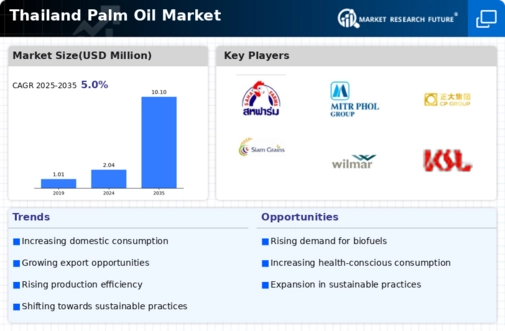International Trade Dynamics
The palm oil market in Thailand is also shaped by international trade dynamics, particularly in relation to export opportunities and competition. Thailand is one of the leading exporters of palm oil in Southeast Asia, with exports accounting for approximately 40% of total production in 2025. The demand for Thai palm oil in key markets, such as China and India, is expected to grow, driven by increasing consumption of palm oil in food and non-food applications. However, competition from other palm oil-producing countries, such as Indonesia and Malaysia, poses challenges. Trade agreements and tariffs can significantly influence the pricing and availability of palm oil, thereby affecting the market landscape. As such, understanding these international trade dynamics is crucial for stakeholders in the palm oil market.
Government Policies and Regulations
The palm oil market in Thailand is significantly influenced by government policies and regulations aimed at promoting sustainable agricultural practices. The Thai government has implemented various initiatives to enhance the productivity of palm oil cultivation while ensuring environmental protection. For instance, the National Palm Oil Policy aims to increase domestic production and reduce reliance on imports. In 2025, the government targets a production increase of 10% to meet rising local demand. Additionally, regulations regarding land use and environmental impact assessments are becoming more stringent, which may affect the operational dynamics within the palm oil market. These policies not only shape the competitive landscape but also encourage investments in sustainable practices, thereby potentially enhancing the market's growth trajectory.
Economic Factors and Market Stability
Economic factors, including fluctuations in commodity prices and overall economic stability, have a significant impact on the palm oil market in Thailand. The market is sensitive to changes in global oil prices, which can influence production costs and profit margins for producers. In 2025, the palm oil market is expected to experience volatility due to varying demand from both domestic and international markets. Additionally, the economic conditions in Thailand, such as inflation rates and currency fluctuations, can affect consumer purchasing power and, consequently, the demand for palm oil products. Understanding these economic factors is essential for stakeholders to navigate the complexities of the palm oil market and make informed decisions regarding production and investment.
Technological Innovations in Cultivation
Technological innovations play a pivotal role in enhancing the efficiency and productivity of the palm oil market in Thailand. Advances in agricultural technology, such as precision farming and biotechnology, are being adopted to optimize palm oil cultivation. These innovations can lead to higher yields and reduced environmental impact, which is increasingly important in the context of sustainability. In 2025, it is projected that the adoption of these technologies could increase palm oil yields by up to 15%, thereby supporting the growing domestic and export demand. Furthermore, the integration of data analytics and IoT in farming practices allows for better resource management, which is essential for maintaining competitiveness in the palm oil market. As these technologies continue to evolve, they are likely to reshape the operational landscape of the industry.
Consumer Preferences for Sustainable Products
In recent years, there has been a noticeable shift in consumer preferences towards sustainable and ethically sourced products, which has a profound impact on the palm oil market in Thailand. As awareness of environmental issues grows, consumers are increasingly seeking products that are certified sustainable. This trend is reflected in the rising demand for palm oil that meets sustainability standards, such as those set by the Roundtable on Sustainable Palm Oil (RSPO). In 2025, it is estimated that around 30% of palm oil consumed in Thailand will be certified sustainable, indicating a significant market shift. This consumer behavior not only drives producers to adopt more sustainable practices but also influences the overall market dynamics, as companies strive to align their offerings with consumer expectations.

















Leave a Comment